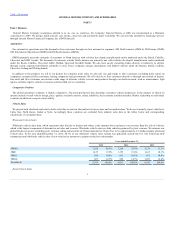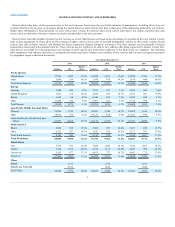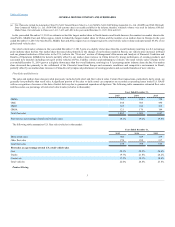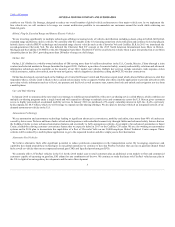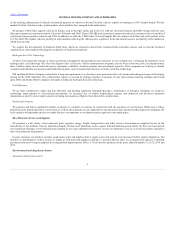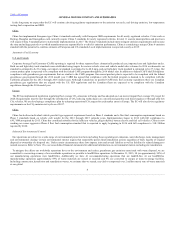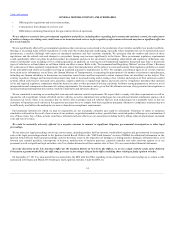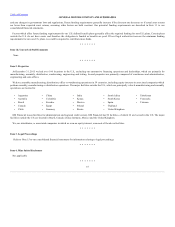General Motors 2015 Annual Report Download - page 12
Download and view the complete annual report
Please find page 12 of the 2015 General Motors annual report below. You can navigate through the pages in the report by either clicking on the pages listed below, or by using the keyword search tool below to find specific information within the annual report.
Table of Contents
manufacturing operations, converted over 140,000 metric tons of waste materials to energy at waste-to-energy facilities and avoided approximately 9 million
metric tons of greenhouse gas emissions in the year ended December 31, 2015.
In addition to minimizing our impact on the environment our landfill-free program and total waste reduction commitments generate revenue from the sale
of production by-products, reduce our use of material, reduce our carbon footprint and help to reduce the risks and financial liabilities associated with waste
disposal.
We continue to search for ways to increase our use of renewable energy and improve our energy efficiency. At December 31, 2015 we had implemented
projects globally that had increased our total renewable energy capacity to over 105 megawatts. In 2015 we also met the EPA Energy Star Challenge for
Industry (EPA Challenge) at seven of our sites globally by reducing energy intensity an average of 22% at these sites. To meet the EPA Challenge industrial
sites must reduce energy intensity by 10% in five years or fewer. Three of the sites achieved the goal for the first time, bringing the total number of GM-
owned sites to have met the EPA Challenge to 73, with many sites achieving the goal multiple times. These efforts minimize our utility expenses and are part
of our approach to addressing climate change through setting a greenhouse gas emissions reduction target, collecting accurate data, following our business
plan and publicly reporting progress against our target.
Chemical Regulations
We continually monitor the implementation of chemical regulations to maintain compliance and evaluate their effect on our business, suppliers and the
automotive industry.
U.S. and Canada
Governmental agencies in both the U.S. and Canada continue to introduce new regulations and legislation related to the selection and use of chemicals or
substances of concern by mandating broad prohibitions, green chemistry, life cycle analysis and product stewardship initiatives. These initiatives give broad
regulatory authority to ban or restrict the use of certain chemical substances and potentially affect automobile manufacturers' responsibilities for vehicle
components at the end of a vehicle's life, as well as chemical selection for product development and manufacturing. Chemical restrictions in Canada are
progressing more rapidly than in the U.S. as a result of Environment Canada’s Chemical Management Plan to assess existing substances and implement risk
management controls on any chemical deemed toxic. These emerging regulations will potentially lead to increases in costs and supply chain complexity. We
believe that we are materially in compliance with these requirements or expect to be materially in compliance by the required date.
The U.S. Congress is currently pursuing an update of the Toxic Substances Control Act to grant the EPA more authority to regulate and ban chemicals from
use in the U.S. which, if passed, is expected to greatly increase the level of regulation of chemicals in vehicles.
Europe
In 2007 the EU implemented its regulatory requirements, the EU REACH regulation among others, to register, evaluate, authorize and restrict the use of
chemical substances. This regulation requires chemical substances manufactured in or imported into the EU to be registered with the European Chemicals
Agency before 2018. Under this regulation, “substances of very high concern” may either require authorization for further use or may be restricted in the
future. This could potentially increase the cost of certain alternative substances that are used to manufacture vehicles and parts, or result in a supply chain
disruption when a substance is no longer available to meet production timelines. Our research and development initiatives may be diverted to address future
requirements. We believe that we are materially in compliance with these requirements or expect to be materially in compliance by the required date.
Safety
In the U.S. the National Traffic and Motor Vehicle Safety Act of 1966 prohibits the sale of any new vehicle or equipment in the U.S. that does not conform
to applicable vehicle safety standards established by the National Highway Traffic Safety Administration (NHTSA). If we or NHTSA determine that either a
vehicle or vehicle equipment does not comply with a safety standard or if a vehicle defect creates an unreasonable safety risk the manufacturer is required to
notify owners and provide a remedy. We are required to report certain information relating to certain customer complaints, warranty claims, field reports and
notices and claims involving property damage, injuries and fatalities in the U.S. and claims involving fatalities outside the U.S. We are also required to report
certain information concerning safety recalls and other safety campaigns outside the U.S.
9




